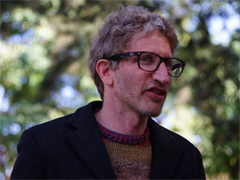This collage of fictional stories about the city and its inhabitants interweaves fragments of films to offer a critical account of gentrification, one of the great inherent conflicts in the socioeconomic model of an epoch when cities have grown and transformed as never before
[Part 1 │ Several languages > English │ 00:21:38 │ Published online by Museo de los Desplazados]
[Part 2 │ Several languages > English │ 00:26:15 │ Published online by Museo de los Desplazados]
Ficción inmobiliaria (Real Estate Fiction) is a “non-profit-making audiovisual research project with artistic, didactic and critical aims” in the words of the authors of this collage of fictions about the city and its inhabitants which reveals the inherent conflicts in the socioeconomic model of an epoch when cities have grown and transformed as never before. Calling themselves Left Hand Rotation (LHR) they are a duo of creators who use their artistic sensibility and sense of humour to denounce the abuses which are interfering with coexistence in social and urban environments. Employing audiovisual means and on-scene action, they educate or simply subversively mock established patterns which they consider unjust.
Much of their work is concerned with gentrification, a process by which the less privileged population of a particular urban sector is expelled when the zone is subject to renovation with a view to attracting residents with greater purchasing power. By means of initiatives such as “Gentrification Is Not a Lady’s Name” or “Museum of the Displaced”, LHR organises educational workshops in neighbourhoods where the victims of gentrification are unaware of the concept, of other equally condemned places and of strategies of resistance. Hence, they bridge the distance that separates the academic definition from real-life experience.
Both parts of Real Estate Fiction use a device similar to a process of interlinking fragments from films to weave a critical account of gentrification. The use of fictional scenes instead of documented facts captures the viewer’s attention, stimulates the imagination, and urges him or her to empathise with a range of real-life situations. The authors say, “Perhaps we can appreciate fictional cinema for its documentary revelations and endow this suggestive narrative genre with new resonances and meanings”. Real Estate Fiction shows a selection of titles from so many different origins and periods that it is evident that gentrification is a scourge in cities all over the world, and that it has been happening for several decades.
Under real estate pressure, the impact of tourism and even the effects of some well-intentioned cultural facilities, neighbourhoods turn into battlegrounds in which the right to housing and the city is threatened by the commodification of the human being’s basic needs. This is a cold war on the worldwide scale which, to a greater or lesser extent, affects cities like São Paulo, Berlin and Barcelona.
Perhaps the best remedy for gentrification is bestowing to domestic space policies aimed at improving public space. Like the street, the home is an instrument of democratisation of the city by means of which it is possible to combat the economic patterns which turn every human need into a commodity. It seems that the administrations of cities like Paris and London are now becoming aware of this as they are implementing public policies in an attempt to keep neighbourhoods from becoming “ghettos for the rich”, whether by acquiring a great number of real estate properties and using them to create social housing, or intervening in the private market in order to set limits to rent prices. Going even deeper in the sense of redefining the model of access to housing and questioning the concept of private property, one is now seeing an expansion of alternative models of tenure. Housing cooperatives and, in particular, “permission to use” policies are consolidating as legal models that offer accessibility, stability and dignity, while avoiding the possibility of speculating on something as fundamental as housing.




